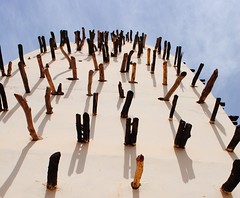With the advice of the gimbri carver we met in the park yesterday we take a bus towards the Kasbah of the Udayas expecting to hear some gnawa music in a concert like venue.
Using the Moroccan GPS we make our way towards what tranpired to be a private address in an old part of the city. As we grow closer to te house the location of the music we were looking for becomes very clear. The rhytmic crash of the krakebs hits the night air and stops us in our tracks, this was unmistakable sound of Gnawa music. We take timid steps closer to the house where we are spotted looking intrigued and are swept into the house through a large timber door. The building, an old riad style house has an open terrace carpetted with traditional rugs and littered with Moroccan antiques. The walls tell the stories of history, swords and daggers, gold leaf paintings with pensive looking warrior characters. The terrace is cushioned with satin pillows and low laying intricately carved tables. In the welcoming palm of each table and cushion sit ornate silver teapots, the smell of their sweet mint tea filling the air.
The intoxicating sound of the Gnawa music is encaptivating and as we stare around the room in awe of the scene sorrounding us it felt as though we might be beautifully invisible. No one is stirred by our unusual presence. We are not questioned as to why we have come. Each individual seems caught in their own moment, the hypnotic rhythm of the krakebs and the soulful tone of the gimbri.
Gnawa music is ancient in its origins, and there are intertwining influences between West African music and the Gnawa tones. Descendents of Sub-Saharan slaves the Gnawa are well known for their traditions of trance like music. The krakebs have an intoxicating effect on the mind, and it’s easy to see how it can induce a trance state. The empowering volume alone is impressive, but it’s the rhythm that tricks the mind. Rhythms are either a loose 4/4 comparable to samba, or a 2 against 3 feel. Short in cycle, you subconsciously hear a different rhythm each time.
A break arrives in the music and we are invited to sit with the musicians who are keen to tell us more about their culture.
‘The thing you must know is that the music we play is a pure form of Gnawa, there is nothing commercial in this. This music is part of our belief system and the people who have come here today are here to heal spiritual ailments.’
The gimbri player, Sadiki sits next to us and prepares his hashish/tobacco mixture before puffing gracefully at a long wooden pipe. Next to him the three krakeb players sip their mint tea quietly and listen to th conversation nodding in agreement at intervals.
‘We are here weekly and local people know of our music and this house. They come here specifically to be healed.’
The break is over and they return to sit and play. Many moments seem to have passed us but we are unaware of how long we have been sat for. Slowly, one by one, the people around us crawl towards the musicians. In trance they move to the rhytyms, shaking their heads, crying and swaying from side to side vigourously. The women who work and live in the house cover them in silk scarves of seven different colours (representing the seven different spirits) and for every person who joins more incense is added to the smoking embers.
The music seems to reach a climax but then draws back again before entering a series of prayers, then another series of songs are played. Finally, as each participant calms and their movements simmer the music so too follows, more prayers are said and a break is taken.
The musicians again join us for tea, this time they are grinning in our direction as they humourously stretch out their hands and fingers, they have been playing now for some 45 minutes continuously.
‘This will continue all night. You see, we are not simply playing songs, every piece is part of a complex set of musical passages which we must finish playing. We will be here all night.’
34.015049
-6.832720


























